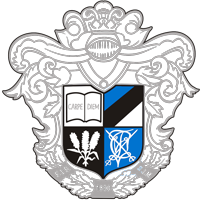The Estonian Students Society (Eesti Üliõpilaste Selts or EÜS in Estonian) is a student organisation founded in 1870. From 1870 to 1940, the Estonian Students Society was active only in Estonia Tartu. After the Soviet Union occupied Estonia in 1940, all student organisations were banned and the Estonian Students Society continued its activities underground. From 1945, various chapters of the Estonian Students Society were formed abroad by expatriate members and began their activities in Sweden, Germany, Australia, England, Canada, the United States and Argentina. In 1988, the Estonian Students Society was re-established in Tartu.
The German name for the Estonian Students Society is Verein Studierender Esten while the Latin version is Societas Studiosorum Estonorum.
The name “Estonian Students Society” came into use in 1883 when the organisation was registered with the University of Tartu as an academic-cultural society. At the time there where no other ethnic Estonian student organisations in Estonia and the choice of name was obvious. After the foundation of the Estonian Students Society “Põhjala” in St. Petersburg in 1884, Fraternities Vironia in 1900 in Riga and Fraternitas Estica in 1907 in Tartu, the Estonian Students Society was no longer a unique Estonian student organisation, nor has the Estonian Students Society ever since intended to unite all Estonian students. Nevertheless, the Estonian Students Society has not considered it necessary to change its name. The term “Estonian Students Society” is also included in the official names of the Estonian Students Society “Põhjala” and the Estonian Students Society “Veljesto” as a general term describing the organisation. These organisations are not related to the Estonian Students Society but are separate organisations.
The Estonian Students Society unites male students of Estonian origin. Up to 1936, all members of the Estonian Students Society were without exception students of the University of Tartu, although from 1936 students of Tallinn Technical University were also accepted. Chapters of the Estonian Students Society overseas accept students from different universities and higher educational institutions. In Estonia today, male students of all universities are accepted as members of the Estonian Students Society.
Estonian Students Society has parntership agreements with five academic organisations. In 1928, we concluded an agreement with Etelä-Pohjalainen Osakunta and Pohjois-Pohjalainen Osakunta of the University of Helsinki, Finland. In 1937, an agreement with Austrums student society from Latvia followed. In 1991, a further agreement was concluded with Vasa Nation of the University of Helsinki. In 2021 agreement was signed with Latvian fraternity Fraternitas Lataviensis. Estonian Students Society and partner organisations exchange visiting students, over a years a close circle of friends has evolved between the members of these organisations.
The Estonian Students Society is an organisation based on the principle of life-long membership. Students who graduate from the university become alumni of the Estonian Students Society. That is why the organisation consists of two legal bodies – the Estonian Students Society, founded in 1870 and registered with the University of Tartu on the 30th of December, 1988, and with Tartu Municipal Government, and the Alumni of the Estonian Students Society, founded in 1884 and registered pursuant to the Non-profit Associations Act of the Republic of Estonia on the 8th of March, 1995 (registration number 80055073).
Currently The Estonian Students Society has over 970 members.
